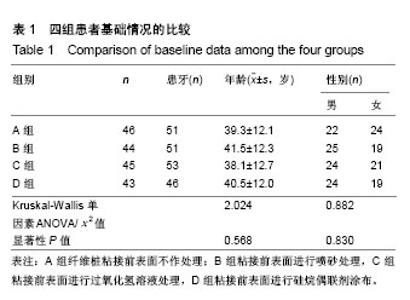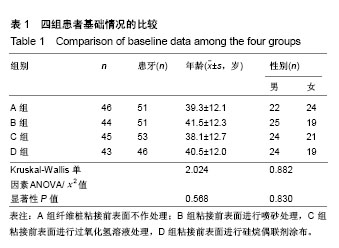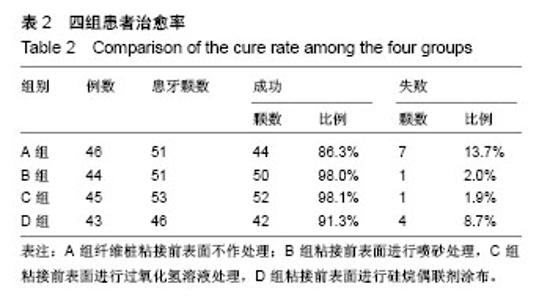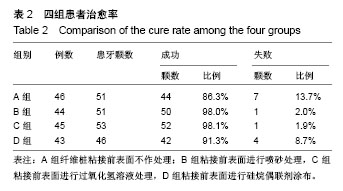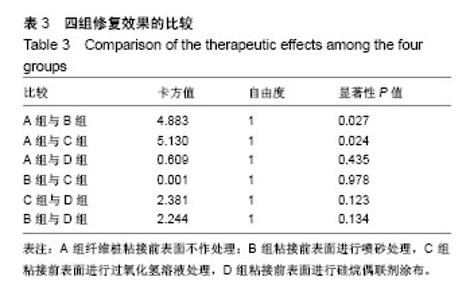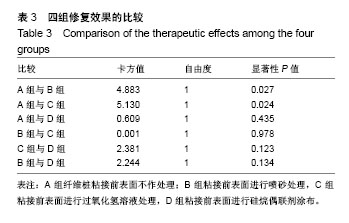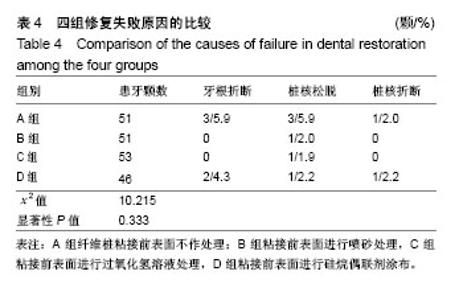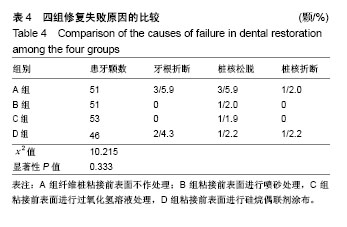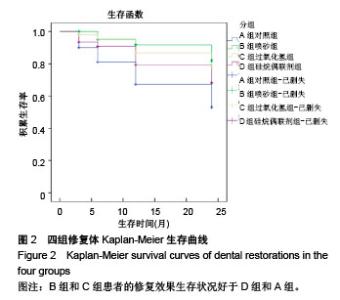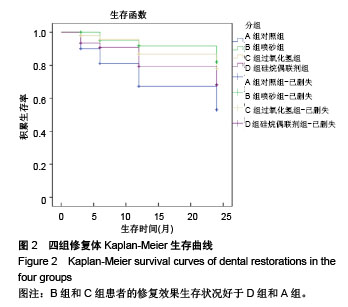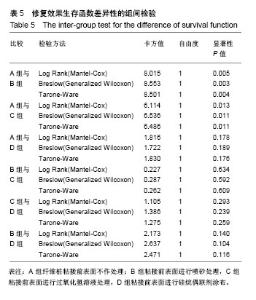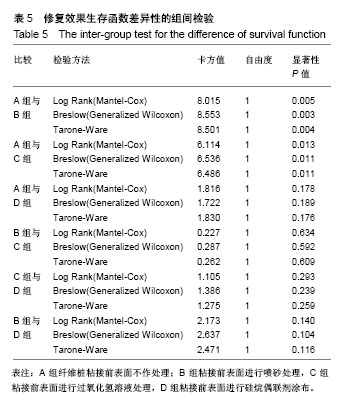Chinese Journal of Tissue Engineering Research ›› 2018, Vol. 22 ›› Issue (22): 3485-3490.doi: 10.3969/j.issn.2095-4344.0750
Previous Articles Next Articles
Clinical effects of glass-fiber posts with different surface treatments on the restoration of tooth defects
Shen Lin, Wang Ting-ting, Yu Shu-ling, Zhang Fang
- Beijing First Hospital of Integrated Chinese and Western Medicine, Beijing 100026, China
-
Received:2017-12-22Online:2018-08-08Published:2018-08-08 -
About author:Shen Lin, Master, Attending physician, Beijing First Hospital of Integrated Chinese and Western Medicine, Beijing 100026, China -
Supported by:the Scientific Research Fund in the Beijing First Hospital of Integrated Chinese and Western Medicine
CLC Number:
Cite this article
Shen Lin, Wang Ting-ting, Yu Shu-ling, Zhang Fang . Clinical effects of glass-fiber posts with different surface treatments on the restoration of tooth defects[J]. Chinese Journal of Tissue Engineering Research, 2018, 22(22): 3485-3490.
share this article
| [1] Lamichhane A,Xu C,Zhang FQ.Dental fi ber-post resin base material: a review J Adv Prosthodont. 2014;6(1):60-65.[2] 浩志超,刘嘉俊,林书弘,等.4种纤维桩X线阻射性的对比研究[J].国际口腔医学杂志,2016,43(4):391-396.[3] 刘颖,袁杰,叶珑伟,等.不同纤维桩的粘结强度及断裂界面研究[J].口腔医学,2017,37(6):500-503.[4] Dikbas I,Tanalp J.An Overview of Clinical Studies on Fiber Post Systems.ScientificWorldJournal. 2013;2013:171380.[5] 赵异.预成纤维桩或可塑纤维桩在口腔修复中的临床效果观察[J].临床和实验医学杂志,2015,14(3):243- 245.[6] Khoroushi M,Mazaheri H,Tarighi P,et al.Effect of antioxidants on push-out bond strength of hydrogen peroxide treated glass fiber posts bonded with two types of resin cement.Restor Dent Endod.2014;39(4): 303-309.[7] Beriat NC,Ertan AA,Yilmaz Z,et al.Effects of different luting ce-ments and light curing units on the sealing ability and bond strength of fiber posts.Dent Mater J.2012;31:575-582.[8] 付东杰,刘志明,王琦,等.石英纤维桩与玻璃纤维桩粘接性能及破坏形式的比较[J].临床口腔医学杂志,2015,31(7):439-441.[9] 吴华英,穆锦全,许祥芹,等.不同表面处理对纤维桩粘结强度的影响及电镜观察[J].口腔医学,2014,34(11):815-818.[10] 翁志强,毛钊,徐辉,等.玻璃纤维桩经表面喷砂后修复上前牙缺损的随访观察[J].医学研究生学报,2011,24(3):259-262.[11] 冯海兰,徐军.口腔修复学[M].2版.北京:北京大学医学出版社, 2013:79-81.[12] 王家安,张新春.Tenax Fiber White 玻璃纤维桩修复前牙残根残冠[J].中华口腔医学研究杂志(电子版),2012,6(1):57-64.[13] Ryge G.Clinical criteria.Int Dent J.1980;30(4):347-358.[14] Sherrard JF,Rossouw PE,Benson BW,et al.Preliminary into fiber pile in the application of oral cavity repair.China Prac Med.2013;8(1):9-11.[15] 赵倩,刘岩.2种非金属桩核修复上前牙残冠临床效果的比较[J].国际口腔医学杂志,2016,43(4):383-386.[16] 陈志健.纤维桩与铸造金属桩在残冠残根修复中的临床效果[J].现代诊断与治疗,2015,26(2):265-266.[17] Bru E,Forner L,Llena C,et al.Fibre post behaviour prediction factors.A review of the literature.J Clin Exp Dent. 2013;5(3):e150-153.[18] Smith DC.Recent developments and prospects in dental polymers.J Prosthetic Dent. 1962;12(6):1066-1078.[19] 沈晴昳,李国强,张强,等.不同纤维桩修复方式影响重度楔状缺损前磨牙的抗折性能[J].中国组织工程研究, 2014,18(25):4004-4008.[20] 钟波,谭建国.纤维桩表面处理改善其树脂粘接强度的研究进展[J].中华老年口腔医学杂志,2013,11(1): 39-42.[21] 陈兰竹,谢伟丽,孙亚杰,等.H2O2溶液表面处理对纤维桩和树脂水门汀粘接强度的影响[J].口腔医学,2015,35(12):1032-1035.[22] Tuncdemir AR,Yildirim C,Güller F,et al.The effect of post surface treatments on the bond strength of fiber posts to root surfaces.Lasers Med Sci.2013;28:13-18.[23] Mosharraf R,Ranjbarian P.Effects of post surface conditioning before silanization on bond strength between fiber post and resin cement.J Adv Prosthodont.2013;5(2):126-132.[24] Perdigao J,Gomes G,Lee IK,et a1.The effect of silane on the bond strengths of fiber posts.Dent Mater.2006;22(8):752-758.[25] 李晓静,赵三军,高宇,等.表面处理及不同水门汀材料对纤维桩粘固性能影响的研究[J].临床口腔医学杂志,2014,30(6):352-355.[26] Valandro LF,Yoshiga S,de Melo RM,et al.Microtensile bond strength between a quartz fiber post and a resin cement: effect of post surface conditioning.J Adhes Dent. 2006;8(2):105-111.[27] 周宇红,许正龙.评价不同的纤维桩表面处理方法对纤维桩修复后牙根抗折裂性能的影响[J].临床和实验医学杂志, 2015,14(22):1902-1905.[28] 肖月,刘欢欢,房殿吉,等.不同表面处理对两种纤维桩粘结强度的影响[J].北京口腔医学,2013,21(3):147-150.[29] Monticelli F,Toledano M,Tay FR,et al.Post-surface conditioning improves interfacial adhesion in post-core restorations.Dent Mater. 2006;22:602-609.[30] 王静,王建鸿,郭菁,等.不同浓度 H2O2 的桩表面处理对玻璃纤维桩与树脂水门汀黏结强度的影响[J].上海口腔医学, 2013,22(5):508-513.[31] 董毅,邓久鹏,王树军,等.纤维桩表面处理技术的研究进展[J].中国组织工程研究,2014,18(25): 4073-4077.[32] 张勇,钟波,谭建国,等.过氧化氢处理提高玻璃纤维桩与树脂水门汀的粘结强度[J].北京大学学报(医学版),2011,43(1):85-88.[33] Vona M,Goracci C,Monticelli F,et al.The adhesion between fibre posts and composite resin cores: the evaluation of microtensile bond strength following various surface chemical treatments to posts.Int Endod J.2006;39(1):31-39.[34] Yenisey M,Kulunk S.Effects of chemical surface treatments of quartz and glass fiber posts on the retention of a composite resin.J Prosthet Dent.2008;99(1):38-45.[35] Monticelli F,Toledano M,Tay FR,et al.A simple etching technique for improving the retention of fiber posts to resin composites.J Endod. 2006;32(1):44-47.[36] 郑虎,郭建青,献芳,等.不同表面处理方法对纤维桩与树脂黏结强度的影响[J].上海口腔医学,2014,23(6):689-694.[37] 熊瑛,陈蕾.不同表面处理方法与纤维桩粘结强度:喷砂及过氧化氢酸蚀与硅烷化处理的差异[J].中国组织工程研究与临床康复, 2010,14(3):457-460.[38] 刘林娟,许建辉,谭玉辉,等.不同表面处理方法对纤维桩树脂粘结力的影响[J].山东医药,2013,53(8):81-83.[39] Goracci C,Raffaelli O, Monticelli F,et al.The adhesion between prefabricates FRC post and composite resin cores:microtensile bond strength with and without post silanization.Dent Mater.2005; 21:437-444.[40] Aksommuang J,Foxton RM,Nakajima M,et al.Microtensile bond strength of a dual cure resin core material to glass and quartz fiber posts.J Dent.2004;32(6):443-450.[41] 李杰,许诺,董明,等.表面处理对纤维桩与牙本质粘结强度影响的实验研究[J].大连医科大学学报,2013,35(5):424-429.[42] Liu C,Liu H,Qian YT,et al.The influence of four dual-cure resin cements and surface treatment selection to bond strength of fiber post.Int J Oral Sci.2014;6(1):56-60.[43] Bitter K,Meyer-Luckel H,Priehn K,et al.Bond strength of resin cements to fiber—reinforced composite posts.Am J Dent. 2006;19(3):138-142.[44] Shirinzad M,Ebadi SH,Shokripour M,et al.An In vitro Evaluation of the Effect of Four Dentin Bonding System on the Bond Strength between Quartz Fiber Post and Composite Core.J Dent (Shiraz). 2014;15(1): 22-27.[45] Machado FW,Bossardi M,Ramos Tdos S,et al.Application of resin adhesive on the surface of a silanized glass fiber-reinforced post and its effect on the retention to root dentin.J Endod.2015;41(1): 106-110.[46] 彭娟红,刘学恒,徐平英,等.不同表面处理的纤维桩微拉伸粘接强度研究[J].口腔颌面修复学杂志,2011,12(4):205-208.[47] 熊瑛.不同表面处理对纤维桩粘结性能和牙根抗折裂强度的影响[D].中南大学,2010.[48] 钟来平,孙坚,郭伟,等.256例局部晚期口腔癌的生存分析[J].中国肿瘤临床, 2015,42(4):217-221.[49] 严齐会,戴锦,郭金炉,等.老年人重度楔状缺损尖牙不同修复方法的效果比较[J].中华老年口腔医学杂志,2017,15(1):14-17. |
| [1] | Zhang Tongtong, Wang Zhonghua, Wen Jie, Song Yuxin, Liu Lin. Application of three-dimensional printing model in surgical resection and reconstruction of cervical tumor [J]. Chinese Journal of Tissue Engineering Research, 2021, 25(9): 1335-1339. |
| [2] | Zeng Yanhua, Hao Yanlei. In vitro culture and purification of Schwann cells: a systematic review [J]. Chinese Journal of Tissue Engineering Research, 2021, 25(7): 1135-1141. |
| [3] | Xu Dongzi, Zhang Ting, Ouyang Zhaolian. The global competitive situation of cardiac tissue engineering based on patent analysis [J]. Chinese Journal of Tissue Engineering Research, 2021, 25(5): 807-812. |
| [4] | Wu Zijian, Hu Zhaoduan, Xie Youqiong, Wang Feng, Li Jia, Li Bocun, Cai Guowei, Peng Rui. Three-dimensional printing technology and bone tissue engineering research: literature metrology and visual analysis of research hotspots [J]. Chinese Journal of Tissue Engineering Research, 2021, 25(4): 564-569. |
| [5] | Chang Wenliao, Zhao Jie, Sun Xiaoliang, Wang Kun, Wu Guofeng, Zhou Jian, Li Shuxiang, Sun Han. Material selection, theoretical design and biomimetic function of artificial periosteum [J]. Chinese Journal of Tissue Engineering Research, 2021, 25(4): 600-606. |
| [6] | Liu Fei, Cui Yutao, Liu He. Advantages and problems of local antibiotic delivery system in the treatment of osteomyelitis [J]. Chinese Journal of Tissue Engineering Research, 2021, 25(4): 614-620. |
| [7] | Li Xiaozhuang, Duan Hao, Wang Weizhou, Tang Zhihong, Wang Yanghao, He Fei. Application of bone tissue engineering materials in the treatment of bone defect diseases in vivo [J]. Chinese Journal of Tissue Engineering Research, 2021, 25(4): 626-631. |
| [8] | Zhang Zhenkun, Li Zhe, Li Ya, Wang Yingying, Wang Yaping, Zhou Xinkui, Ma Shanshan, Guan Fangxia. Application of alginate based hydrogels/dressings in wound healing: sustained, dynamic and sequential release [J]. Chinese Journal of Tissue Engineering Research, 2021, 25(4): 638-643. |
| [9] | Chen Jiana, Qiu Yanling, Nie Minhai, Liu Xuqian. Tissue engineering scaffolds in repairing oral and maxillofacial soft tissue defects [J]. Chinese Journal of Tissue Engineering Research, 2021, 25(4): 644-650. |
| [10] | Xing Hao, Zhang Yonghong, Wang Dong. Advantages and disadvantages of repairing large-segment bone defect [J]. Chinese Journal of Tissue Engineering Research, 2021, 25(3): 426-430. |
| [11] | Chen Siqi, Xian Debin, Xu Rongsheng, Qin Zhongjie, Zhang Lei, Xia Delin. Effects of bone marrow mesenchymal stem cells and human umbilical vein endothelial cells combined with hydroxyapatite-tricalcium phosphate scaffolds on early angiogenesis in skull defect repair in rats [J]. Chinese Journal of Tissue Engineering Research, 2021, 25(22): 3458-3465. |
| [12] | Wang Hao, Chen Mingxue, Li Junkang, Luo Xujiang, Peng Liqing, Li Huo, Huang Bo, Tian Guangzhao, Liu Shuyun, Sui Xiang, Huang Jingxiang, Guo Quanyi, Lu Xiaobo. Decellularized porcine skin matrix for tissue-engineered meniscus scaffold [J]. Chinese Journal of Tissue Engineering Research, 2021, 25(22): 3473-3478. |
| [13] | Mo Jianling, He Shaoru, Feng Bowen, Jian Minqiao, Zhang Xiaohui, Liu Caisheng, Liang Yijing, Liu Yumei, Chen Liang, Zhou Haiyu, Liu Yanhui. Forming prevascularized cell sheets and the expression of angiogenesis-related factors [J]. Chinese Journal of Tissue Engineering Research, 2021, 25(22): 3479-3486. |
| [14] | Liu Chang, Li Datong, Liu Yuan, Kong Lingbo, Guo Rui, Yang Lixue, Hao Dingjun, He Baorong. Poor efficacy after vertebral augmentation surgery of acute symptomatic thoracolumbar osteoporotic compression fracture: relationship with bone cement, bone mineral density, and adjacent fractures [J]. Chinese Journal of Tissue Engineering Research, 2021, 25(22): 3510-3516. |
| [15] | Liu Liyong, Zhou Lei. Research and development status and development trend of hydrogel in tissue engineering based on patent information [J]. Chinese Journal of Tissue Engineering Research, 2021, 25(22): 3527-3533. |
| Viewed | ||||||
|
Full text |
|
|||||
|
Abstract |
|
|||||


